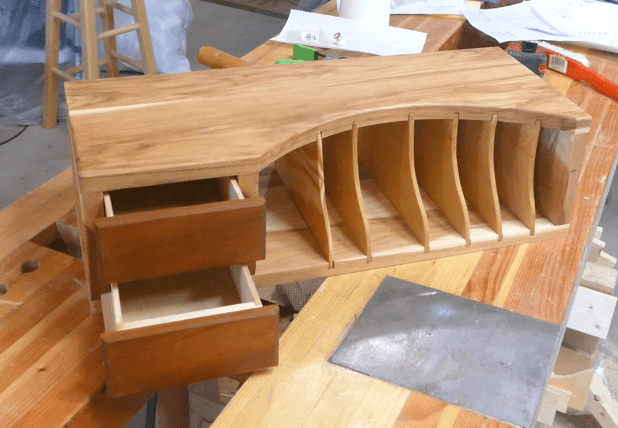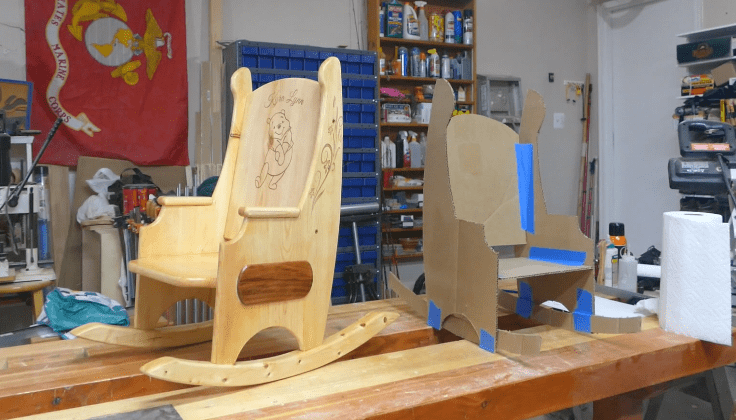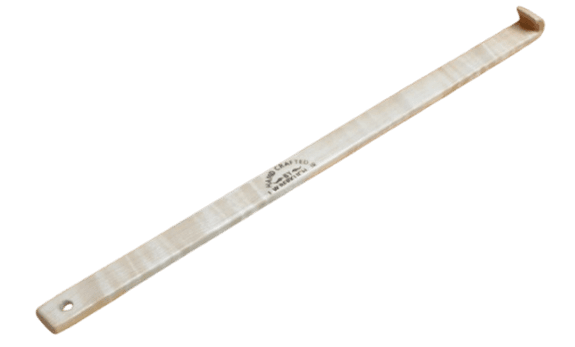
Here’s a really easy plane gallery that you can build to store your smaller planes. While not a 30-minute project it will be well worth your time and will help get your shop organized so you can work more efficiently.

For me it is a project that I desperately need to get my shop organized. I don’t use my planes as much as I could simply because I cannot easily grab them.
And follow this link to my Video to see how it is done.
Tools and Materials
While you can make this out of any wood you choose, storing and displaying your hand planes seems to require something a bit better than pine. I chose Hickory and Mahogany. Depending on how many planes you have and how large a gallery you want to build you’ll need several feet of Hickory about 10 inches wide. You also need another 5 or 6 feet of quarter inch material for the separators, a 6” x 18” piece of quarter inch plywood, 2’ x3’ by ¾” Plywood, and about 6 feet of 2 inch wide, quarter inch Poplar for the drawers. And finally, you’ll need something like mahogany, walnut, or cherry for the drawer faces.
Though you can do this project solely with hand tools, some specialty tools will make it faster and easier to construct. A power planer makes very short work of the acute angle at the top of the panel. A circle saw or a table saw size and cross cut the material. And a drill motor and impact driver will make it really easy to complete the project.

Layout
So basically, you’re building a box. The only important or different layout items you’ll encounter here are going to be the curved cutout in the top which allows easy access to taller planes such as Stanley 78 and the grooves you need for the separators. Note, the dimension sketch does not include locations for grooves because you’ll have to determine that based on your planes.
Additionally, you will need to determine dimensions for the till drawers as you see fit. But that’s an easy task. You will notice that I decided on just 2 drawers. I did that because of the size/configuration of the Stanly No. 78 parts. The 1” deep drawers just would not work.


Cutting
So cutting here is really pretty straightforward at least the basics are because you’re building effectively a box with only four sides. So assuming you’re using the dimensions I have in the sketch you’re going to have to size the width of the top and bottom.

The next step in this dance is to make sure all the pieces are the same thickness so you’ll have to run them through a planer. If you’re buying lumber directly from a mill or from a big box store you can make sure that all the pieces are the same thickness.
[planning]

Then crosscut to the appropriate length and do the same for the right side, the left side, and the drawer center.

More Cutting
Yes there’s a bit more cutting your next step is to lay out the curve in the top piece. You can do this by cutting a 316 since thick piece of pine Maple or cherry that’s about 3/4 of an inch wide and three feet long. Drill a hole in each end about 1/2 inch in then run a string through it just like an archery bow. If you use a top hitch on one end you could make it adjustable too. Next layout the dimensions you’re looking to achieve which is going to be the right and left side at the front edge and then the depth of the curve. Bend and tension the bow until you achieve something pretty close to this curve. Lay it on the three Marks and mark it.

With the curve laid out head over to the Bandsaw or take your Sabre saw and cut the curve.

Faring the Curve
With the curve cut you may need to do some clean up work. You can do this with a rasp and a file and some sandpaper or like me you can use the Oscillating Belt Sander. The Oscillating Belt Sander makes short work of this which is why I love it.
Laying Out and Cutting the Dados
Now we’re into the customization of the plane gallery. You need to layout your planes with about 3/4 of an inch between each to figure out where you’re going to place dividers. The easy button for this part of the project is to cut several ¾” wide sticks that you can place between your plane planes as spacers. With those in place you could mark the center lines while you’re dividers do this on both pieces the top and the bottom.
Next set up 1/4 inch wide dado blade 1/4 inch high, put an offset block on your table saw fence, set the dimension and start cutting. Be sure you cut both the top and the bottom at the same time. And make sure the parts are oriented properly.
Be sure that you mark the side and the center section for dados for the drawers.

Sanding
Your carcass parts are ready for sanding. They had all the flat surfaces at edges with 220 grit sandpaper and be sure to sand out any burn marks along the edges.
Carcass Assembly
With everything sanded the carcass is ready to be assembled. You have a wide range of choices in how to do this, I used a Kreg Jig and glue. You can of course use screws or nails.
Drawer Layout
With the carcass assembled you can start on the drawers. These drawers are super easy. The material these drawers should be quarter inch Poplar. Measure across from the bottom of a dado to the bottom of the dado on the opposite side then subtract 1/16th of an inch. Do the same for the front to back measurement. Cut the drawer bottoms to this dimension.
The drawer sides will be the same as the front to back measurement of the drawer bottom Minus ¼”. The quarter inch dimension it’s for the rabbets needed in the front and the backs.
The fronts and backs will be the same as the cross dimension of the bottom minus 5/8”. This dimension takes into account the quarter inch deep dados as well as the 1/16th inch clearance and an additional 1/16th inch clearance. You will need to put a 1/8 deep by 1/4 inch wide rabbet in the end of each drawer front and back.
Drawer Assembly
At this point drawer assembly is really simple. Glue and clamp the parts together for the drawer sides, front, and backs making sure they are square and let them dry. Once they’re dry glue them in place onto the drawer bottoms. Be sure to use enough glue because you’re depending only on glue to hold these together you may want to use some 18 gauge nails to pin them but it’s really not necessary.
With the drawers glued up you’ll need to put a face on them. I chose to use quarter inch mahogany. I also chose to overlay them.

Making the divider panels
You’ll need to make a series of divider panels. These are nothing more than quarter inch thick panels that at the bottom are the same depth as the carcass and at the top are the same depth as the curve. Easy way to do this is to use a French curve. Grab some cardboard and size it to fit into each one of the slots then use a French curve to allow a cutaway for each of the panels. Each panel will be different.
With the curves laid out on the cardboard cut them out and then use these as templates for creating the actual panels in wood. You can cut these out using a coping saw a band saw or a jigsaw. Be sure to fear the curves with sandpaper or a file to remove any marks and sand all the corners round.
Finishing
You have lots of finishing choices for this project. I chose to use boiled linseed oil because it’s easy to apply quick to dry and is sufficient for the amount of contact this project would receive. Also it’s easy to apply. All I did was wipe on a sufficient amount of boiled linseed oil allow about 10 minutes for it to soak in and then wipe it all off. This provides a beautiful finish for the Hickory that I chose.
I applied boiled linseed oil finish to all the parts including the drawers and divider panels.

The Wrap Up
For me this was a great project and one that I’m going to find really useful. It fits my tool cabinet perfectly because of course that’s how I designed it. I already love having easy access to my planes so I can pick and choose which one I need whenever I have to do a task.

I hope you take the time to make this project to get organized or at least make something like this because I believe it will be a huge help in your shop.
If you do make this project, congratulations on a job well done. And do me a favor and post it on my Facebook page (see link below).
Hope you got something out of this and if you did, do me a favor, hit like and subscribe. I’d appreciate that a lot.
Thanks for reading and until next time Good Making!
Bill
Visit my Etsy Store at www.etsy.com/shop/30MinuteWoodshop
Facebook https://www.facebook.com/30MinuteWoodshop
Links to my Videos and Blogs
Create Your Own Dice Vault https://30minutewoodshop.com/?p=1226
DIY Whiskey and Cigar Butler https://30minutewoodshop.com/?p=550
Farmhouse Key Rack https://youtu.be/I65FGq4dKYY
Create Your Own Lazy Susan https://30minutewoodshop.com/?p=491
Tools and Materials you may need
DEWALT Drill and Driver Combo https://amzn.to/42yybmy
DEWALT Router Plunge Base Kit https://amzn.to/3LKkJEK
Ridgid Oscillating Belt Sander https://amzn.to/45C3rTK
Starrett Combination Square https://amzn.to/3XpbrDN
WoodRiver Low Angle Block Plane https://amzn.to/3pkNvos
Milwaukee M18 Jig Saw Kit https://amzn.to/3FAWXsS
BOSCH Compound Miter Saw https://amzn.to/421A1vl
Minwax Fast Drying Polyurethane https://amzn.to/3V5h0pO
PPE Gear






